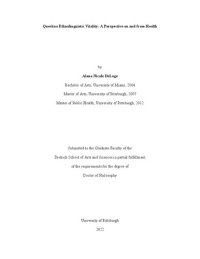
Ebook: Quechua Ethnolinguistic Vitality: A Perspective on and from Health
Author: Alana Nicole DeLoge
- Genre: Linguistics // Foreign
- Tags: Sociolingüística, Sociolinguistics, Análisis del discurso, Discourse Analysis, Análise do discurso, Cambio social, Mundança social, Social Change, Quechua, Andes, Andean Linguistics, Lingüística andina, Lingüística quechua, Peru, Qichwa, Qhichwa, Cuzco, Cusco, Latin America, Americas, América latina, Latinoamérica, Bolivia
- Series: PhD Dissertation
- Year: 2022
- Publisher: University of Pittsburgh
- Language: English
- pdf
This dissertation increases our understanding of the ethnolinguistic vitality (EV) of one
variety of Quechua and expands our understanding of what it means for a language to be vital.
Utilizing a sociolinguistics of language contact approach, in which the connections among
languages and cultures in contact necessarily underlie outcomes of EV, I explore three distinct
cases to demonstrate EV within the domain of health for Cochabamba Quechua, a subvariety of
Southern Quechua spoken in and around the city of Cochabamba, Bolivia.
A series of ten sociolinguistic interviews provide the data for the first two analyses. In the
first analysis, language ideologies and attitudes emerge that inform Quechua EV, e.g., the Spanish
language is associated with that which is academic and scientific, while Quechua is understood as
oppositional to this. These ideologies do not demonstrate high EV: Quechua is not valued, but
rather is a tool for a hegemonic healthcare system. In the second analysis, I demonstrate that the
discourse marker a veces, or ‘sometimes,’ is used as a reportative evidential marker that can also
denote negative affective stance in Andean Spanish, a result of contact with Quechua and other
indigenous languages. Both the presence of a veces within Andean Spanish and that it is a resource
through and with which speakers navigate social realities denote potential for Quechua EV.
Finally, analyzing Cochabamba Quechua outside of Cochabamba, COVID-19 informational
videos presented through internet channels and a speech event contributing to the development of
a Quechua language textbook also suggest high EV for Quechua because they indicate significant
social capital.
v
In addition to a greater understanding of Quechua EV, this dissertation also demonstrates
the necessity to consider the linguistic ecology, through ethnographic and interactional data, to
determine how EV is identified and analyzed. Rather than classifications along a high to low
continuum, for example, studies of EV might consider looking at where and how vitality manifests,
i.e., what Quechua speakers do, how they do it, and how EV manifests in these very particular
contexts.
variety of Quechua and expands our understanding of what it means for a language to be vital.
Utilizing a sociolinguistics of language contact approach, in which the connections among
languages and cultures in contact necessarily underlie outcomes of EV, I explore three distinct
cases to demonstrate EV within the domain of health for Cochabamba Quechua, a subvariety of
Southern Quechua spoken in and around the city of Cochabamba, Bolivia.
A series of ten sociolinguistic interviews provide the data for the first two analyses. In the
first analysis, language ideologies and attitudes emerge that inform Quechua EV, e.g., the Spanish
language is associated with that which is academic and scientific, while Quechua is understood as
oppositional to this. These ideologies do not demonstrate high EV: Quechua is not valued, but
rather is a tool for a hegemonic healthcare system. In the second analysis, I demonstrate that the
discourse marker a veces, or ‘sometimes,’ is used as a reportative evidential marker that can also
denote negative affective stance in Andean Spanish, a result of contact with Quechua and other
indigenous languages. Both the presence of a veces within Andean Spanish and that it is a resource
through and with which speakers navigate social realities denote potential for Quechua EV.
Finally, analyzing Cochabamba Quechua outside of Cochabamba, COVID-19 informational
videos presented through internet channels and a speech event contributing to the development of
a Quechua language textbook also suggest high EV for Quechua because they indicate significant
social capital.
v
In addition to a greater understanding of Quechua EV, this dissertation also demonstrates
the necessity to consider the linguistic ecology, through ethnographic and interactional data, to
determine how EV is identified and analyzed. Rather than classifications along a high to low
continuum, for example, studies of EV might consider looking at where and how vitality manifests,
i.e., what Quechua speakers do, how they do it, and how EV manifests in these very particular
contexts.
Download the book Quechua Ethnolinguistic Vitality: A Perspective on and from Health for free or read online
Continue reading on any device:

Last viewed books
Related books
{related-news}
Comments (0)